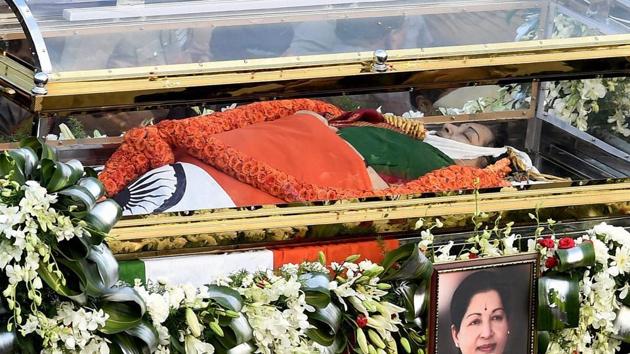Not Amma to all: The other side of Jayalalithaa’s legacy
Social media was flooded with articles and videos that celebrated the “Iron Lady” for her policy grit and personal charisma. She was rightly credited for steering the southern state to becoming India’s second-largest state economy, turning Chennai into an automobile hub and attracting billions of dollars in industrial investment across Tamil Nadu.
Death is a great leveler. It is also a great eraser, especially of unsavoury memories and problematic legacies.

The passing of six-time Tamil Nadu chief minister J Jayalalithaa unleashed a surge of obeisance for three days as commentators lauded her decisiveness, leadership and governance.
Social media was flooded with articles and videos that celebrated the “Iron Lady” for her policy grit and personal charisma. She was rightly credited for steering the southern state to becoming India’s second-largest state economy, turning Chennai into an automobile hub and attracting billions of dollars in industrial investment across Tamil Nadu.
The deluge of mourners devastated at the loss of their beloved Amma also shone light on her welfare schemes that ranged from state support for abandoned babies, women and the poor to her enduring brand of cheap but healthy canteens, free medicines and water.
To the poor and downtrodden of Tamil Nadu – especially women – she was a benevolent mother who touched their lives through her runaway-hit schemes. They rewarded her by voting her back to power in the last assembly elections, a feat no one had achieved in 30 years.
She also enacted what is considered India’s most robust social justice scheme that assures 69% reservation to a wide range of weaker sections. Just two years into her first stint in 1993, the imperious politician lobbied the central government to put Tamil Nadu’s ingenious quota system beyond judicial review and it remains the only state to have done so – a curious omission from most of her otherwise gushing obituaries.
Her rightful achievements makes for good headlines and even better posturing as speaking ill of the deceased is considered bad form. But such adulation distorts the truth, especially surrounding one of India’s tallest and most complex leaders whose legacy is a complicated mesh of caste and gender.
A common criticism of Jayalalithaa is that of corruption – she was convicted twice of amassing wealth disproportionate to her income. But a less discussed aspect of the AIADMK chief was her questionable record on atrocities against the lower castes.
She was chief minister in 2011 when the state police fired at a gathering in south Tamil Nadu’s Ramanathpuram district, killing seven Dalit villagers.
Jayalalithaa constituted an inquiry commission but did little to mitigate simmering caste tensions between the dominant Thevars and Dalits that continue to claim lives in a state where, ironically, every leader swears by anti-caste Dravidian ideology.
A year later on the other side of the state, hundreds of Dalit homes were set ablaze in Dharmapuri as a mob of intermediate caste Vanniyars went on an uncontrolled rampage while an outnumbered police force stood by and watched. The trigger for the violence: Their caste pride had been wounded by a Dalit boy and a Vanniyar girl who defied a local panchayat diktat against their love and fled the region.
The boy, Ilavarasan, was found dead by the local railway tracks, becoming the face of festering caste hatred that had spurred a rash of “honour killings”. His killers have still not been convicted.
A year later, clashes between cadre of the PMK and Dalit villagers in the state’s Villupuram district left two people dead.
Earlier this year, Ilavarasan’s fate was repeated when a Dalit boy, Shankar, was hacked to death in full public view in Udhumalpet by his upper-caste in-laws – the entire country witness to the horror via a live close circuit camera recording that went viral.
In between these high-profile cases, the rubric of Tamil Nadu’s Periyar-centric ideology was steadily eroded as intermediate castes – such as Thevars, Gounders and Vanniyars – took on a neo-oppressor role for Dalits.
The AIADMK presided over a large part of this reign and counted most of these dominant castes as support – Jayalalithaa’s confidante Sasikala and Tamil Nadu’s new chief minister O Pannerselvan are both Thevars. Additionally, the party fought elections in alliance with the PMK – said to have fanned anti-Dalit sentiment across the state – three times.
But it wasn’t just caste atrocities where the 68-year-old’s record was poor. She also famously brooked no dissent and in her last term, filed more than 200 defamation cases against opponents and journalists, sometimes for merely reporting criticism of her policies.
She filed cases against anyone who reported on her supposedly poor health, forcing on one instance the web portal Rediff to take down an article. More than a dozen cases were filed against the Times of India, The Hindu, Tamil newspaper Dinamalar, compelling the Supreme Court to rebuke the state government and accuse it of “throttling democracy”.
Jayalalithaa’s career was a mash-up of controversial and visionary decisions, clever politicking and costly mistakes. She was a tough decision maker who fought gender abuse for years in a male-dominanted political scene – a reason, many say, for her famously icy exterior and demand of total loyalty from her followers.
A leader who commanded the devotion of legions of supporters and humiliated entrenched opponents cannot be someone with a straightforward legacy. In choosing to gloss over her imperfections and blunders, we are doing a disservice to one of the most important leaders of our times and how history might end up judging her.
(Views expressed are personal. The author tweets @dhrubo127)





